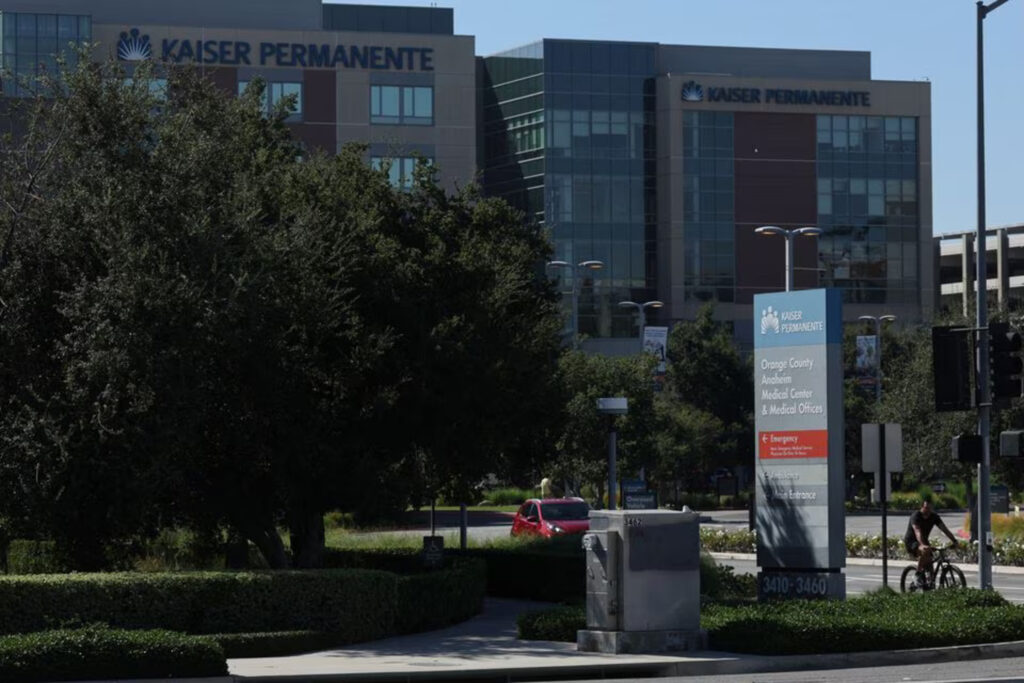“Kaiser Permanente faces a major labor showdown with 75,000 healthcare workers as contract talks stall, threatening a record-breaking strike across multiple states. Get the latest on this high-stakes labor dispute and its potential impact on healthcare services.”
In a tense standoff, Kaiser Permanente, one of the leading not-for-profit healthcare networks and managed-care organizations in the United States, is inching closer to a major labor clash with approximately 75,000 of its healthcare workers. Union leaders have declared that contract negotiations have hit an impasse, setting the stage for a potentially disruptive three-day strike across several states.
Kaiser Permanente

The looming strike deadline is set for 6 a.m. PDT (1300 GMT) on Wednesday. This deadline represents the last opportunity for the parties involved to reach a tentative agreement on a new labor pact. The affected healthcare professionals include nurses, medical technicians, and support staff spread across hundreds of hospitals in California, Oregon, Washington State, Colorado, Virginia, and Washington, D.C.
This potential strike is noteworthy as it would mark the largest in the history of the U.S. medical industry, with over 75,000 workers poised to participate. Despite the impending strike, Kaiser Permanente has reassured the public that its hospitals and emergency departments will remain operational, thanks to the presence of doctors, managers, and other non-union “contingency workers.”
As of now, the Coalition of Kaiser Permanente Unions, representing 85,000 Kaiser employees, claims that the healthcare giant has not put forward acceptable terms to address critical staffing shortages or to meet the workers’ demands for improved pay and benefits. The previous four-year contract expired on September 30, adding to the urgency of the situation.
Negotiations came to a halt on Tuesday afternoon, leaving just 17 hours before the strike deadline, according to the union coalition. Caroline Lucas, the executive director of the union coalition, stated, “Both management and union negotiators are on standby waiting for Kaiser executives to resolve their internal debate about whether to do what it takes to reach an agreement.”
In response, Kaiser spokesperson Hilary Costa disputed the union’s claim of a standstill, stating that contract talks “are ongoing.” She reiterated Kaiser’s commitment to negotiating earnestly and being available around the clock to reach a fair agreement. “We remain optimistic that there is still an opportunity to reach a deal before any work stoppages begin at 6 a.m. on Wednesday,” she added.
Even if a strike does occur, approximately 60% of Kaiser’s workforce will remain on the job, as facilities in Georgia, Hawaii, and most of Washington State will not be affected. However, the impact on patients in California, Colorado, Oregon, and parts of southwestern Washington State would be more significant. Staffing levels have emerged as a major point of contention, with the union insisting that Kaiser needs to hire an additional 10,000 healthcare workers to address existing vacancies.
Wage disputes are another significant issue. Kaiser has stated that it has proposed wage increases ranging from 12.5% to 16% across the board over a four-year period, asserting that the company leads in “total compensation” in all markets where it operates.
It is important to note that Kaiser has reported substantial profits, with $3 billion in earnings during the first half of 2023 and over $24 billion in the past five years. As a non-profit organization, Kaiser is exempt from income tax on its earnings and pays minimal property taxes.
The labor market’s tight conditions and the specter of inflation have contributed to contentious contract negotiations and strikes across various industries this year, including the automotive and entertainment sectors. According to the U.S. Bureau of Labor Statistics, nearly 309,700 workers have been involved in work stoppages through August this year, potentially making 2023 the busiest year for strikes since 2019.
also read Project Nessie

[…] also read Kaiser Permanente […]